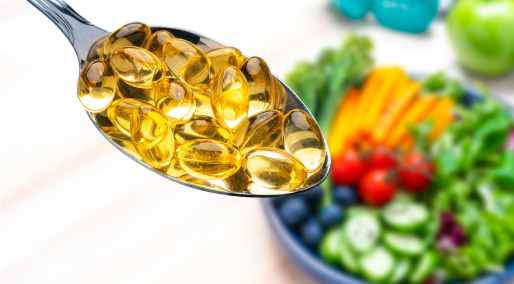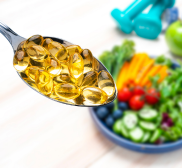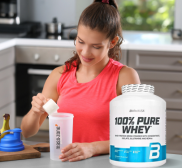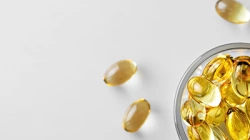.webp)
.webp)

Patryk Chodyniecki
Update date: 18-09-2024
Diet in atherosclerosis
Miażdżyca to schorzenie układu sercowo-naczyniowego. Częściej dotyka mężczyzn niż kobiety. Diagnozowana jest głównie po 35. roku życia. Częściej występuje u osób palących tytoń, otyłych, nadużywających alkoholu, z cukrzycą, nadciśnieniem, narażonych na stres. To coraz bardziej powszechna choroba. Duże znaczenie w jej terapii ma właściwa dieta. O czym trzeba wtedy pamiętać?
- DIET FOR ATHEROSCLEROSIS. WHAT TO EAT AND WHAT TO AVOID?
- WHAT IS ATHEROSCLEROSIS?
- WHAT FACTORS INCREASE THE RISK OF ATHEROSCLEROSIS?
- CAUSES AND SYMPTOMS OF ATHEROSCLEROSIS
- CHOLESTEROL AND HEART - RELATIONSHIP WITH ATHEROSCLEROSIS
- VEGETABLE FATS - DIET AGAINST ATHEROSCLEROSIS
- HOW IS ATHEROSCLEROSIS DIAGNOSED?
- HOW IS ATHEROSCLEROSIS TREATED?
- DIET FOR ATHEROSCLEROSIS
- PRODUCTS RECOMMENDED FOR PEOPLE WITH ATHEROSCLEROSIS
- Take advantage of the discount
DIET FOR ATHEROSCLEROSIS. WHAT TO EAT AND WHAT TO AVOID?
Atherosclerosis is a disease of the cardiovascular system. It affects men more often than women. It is diagnosed mainly after the age of 35. It is more common in people who smoke, are obese, abuse alcohol, have diabetes, hypertension and are exposed to stress. It is an increasingly common disease. A proper diet is of great importance in her therapy. What should you remember then?
WHAT IS ATHEROSCLEROSIS?
Atherosclerosis involves degenerative changes in the media and intima of the arteries supplying blood to the heart, brain, limbs and other organs. The so-called atherosclerotic plaque then appears, narrowing the lumen of the arteries. They also become fibrotic, calcified, and as a result, they function incorrectly. Usually, in the initial phase, atherosclerosis does not cause any symptoms, but then suddenly it causes a serious threat to health and even life, because it can cause a heart attack. Genetic conditions also play an important role in atherosclerosis. Coronary heart disease in the family increases the risk of developing the disease. However, it can be prevented — proper diet and physical activity are crucial.
WHAT FACTORS INCREASE THE RISK OF ATHEROSCLEROSIS?
Factors that increase the risk of atherosclerosis are divided into different categories.
These are mainly:
· genetic factors – ischemic heart disease,
· biochemical factors – large amount of fibrinogen, left ventricular hypertrophy,
· insulin resistance– abnormal glucose tolerance,
· excess lipids – cholesterol and triglycerides, increased platelet activity, proteinuria
· environmental factors – lack of exercise, obesity, stress, alcoholism, smoking, hypertension, diabetes,
· other factors – male gender, age over 35.
The risk is also increased by an incorrect diet:
· a diet rich in animal fats and meat,
· not enough fiber — vegetables, fruits, whole grain products,
· deficiencies of vitamins A, C, E, beta-carotene and minerals such as iron, chromium, copper, magnesium, selenium.
CAUSES AND SYMPTOMS OF ATHEROSCLEROSIS
A factor indicating the risk of atherosclerosis is increased cholesterol. Increased rates often concern older people who are physically inactive and have an incorrect diet. Cholesterol combines with proteins in the blood plasma to form lipoproteins.
It is divided into:
· good HDL cholesterol — high-density lipoproteins responsible for normalizing cholesterol levels, reduced amounts are diagnosed in people who smoke, drink alcohol, and have a diet rich in carbohydrates
· bad LDL cholesterol — low-density lipoproteins are responsible for transporting cholesterol from the liver to the tissues
Triglycerides, which are produced in the liver from fatty acids, are also of great importance. They lead to blood clots and increase the risk of a heart attack. Their amount in the body is increased by a diet rich in carbohydrates and obesity. In turn, they are reduced by Omega-3 polyunsaturated fatty acids, selected herbs, and exercise.
CHOLESTEROL AND HEART - RELATIONSHIP WITH ATHEROSCLEROSIS
The first thing we should do at this point is to check the cholesterol level in the blood. In this case, we are talking about testing bad and good cholesterol. When we exceed the norm(190 mg/dl total cholesterol), we should consider whether we belong to the risk group of atherosclerosis. The best solution in this case is to consult the results with a doctor. If the concentration of cholesterol in our blood is excessive, a pathological phenomenon occurs, which involves its deposition in the walls of blood vessels. At this point we are dealing with the beginnings of atherosclerosis. If there is too much LDL lipoprotein and too little HDL circulating in the blood, atherosclerotic plaques build up in the walls of the arteries, which increases ischemic heart disease. Elevated cholesterol is one of the basic factors of coronary heart disease. However, this can be prevented by taking medications or changing your diet.
VEGETABLE FATS - DIET AGAINST ATHEROSCLEROSIS
If we want to lower cholesterol levels, we must focus on fats. Thanks to them, we should have access to about 30-35% of energy throughout the day.
About 10% of the above value should besaturated fatty acids. Otherwise, it is worth supplementing them by consuming high-quality vegetable fats, which are necessary for the proper functioning of our body.
The best fats in this case come from:
- olive oil,
- sea fish,
- soft margarines.
The presence of fats in the diet is necessary, but we must remember that their quality is important. People who suffer from atherosclerosis can eat meat. However, when choosing, you should choose lean cuts and eat small portions.
Recommended in this case:
- fish,
- poultry without skin.
Carbohydrates should constitute 60 percent of the energy value of the diet. It is worth focusing on vegetables and fruits, as well as whole grain products. It is also worth choosing milk and dairy products with reduced fat content, and limiting the consumption of simple sugars, sugar, sweets and alcohol. Salting food should be done as rarely as possible. Interestingly, salt can be easily replaced with spices and herbs that will add a unique flavor to the dishes.
HOW IS ATHEROSCLEROSIS DIAGNOSED?
Diagnosis is performed using ultrasound examination — it allows for diagnosis when the patient has a lot of atherosclerotic plaques. Computed tomography and coronary angiography are also used. It is advisable to systematically check your cholesterol level. Its amount in the blood should not exceed 200 mg/dl. When there is a lot of it, it is recommended to perform lipidosis, i.e.:
· total cholesterol,
· LDL and HDL cholesterol fractions,
· triglycerides.
HOW IS ATHEROSCLEROSIS TREATED?
The goal is to reduce cholesterol levels. This effect is achieved by using appropriate drugs that normalize its levels. The most commonly used are ion exchange resins, statins, fibrates and preparations containing nicotinic acid derivatives.
· Ion exchange resins are responsible for binding bile acids, therefore the body produces them again from cholesterol, which reduces its level.
· Statins are HMG-CoA reductase inhibitors – it is an enzyme involved in the synthesis of cholesterol in the body. Additionally, they reduce atherosclerotic lesions that already exist. However, they may have a negative effect on the muscles and liver.
· Fibrates have a complex mechanism of action and lead to the reduction of triglycerides and cholesterol. They cannot be used with statins because they pose a risk to the muscles. Other types of ancillary medications are also used.
Additionally, the following methods are used in atherosclerosis:
· ballooning – the procedure involves placing a coil in the artery, increasing its volume and removing cholesterol deposits, also leads to the expansion of the artery.
· stents — special structures placed in the artery prevent deposits from overgrowing.
· by-passes– bypass surgery. A healthy vein from the patient is used and sewn into a new place.
DIET FOR ATHEROSCLEROSIS
A proper diet is also very important in the treatment of atherosclerosis, so the patient should remember to eat it every day. It reduces cholesterol and triglyceride levels and reduces the risk of recurrence. In the diet, it is important to limit the consumption of animal fats and other fatty foods, for example: fatty meats, lard, bacon, butter, and yellow cheese. You should also avoid products containing coconut and palm oil. A diet for atherosclerosis should contain large amounts of essential fatty acids. unsaturated fatty acids.
Unsaturated fatty acids are divided into:
· omega-6 polyunsaturated fatty acids — they lower total and LDL cholesterol, reduce the risk of blood clots, are found mainly in vegetable oils: corn, sunflower, soybean, and also in margarine.
· omega-3 polyunsaturated fatty acids — normalize heart function, reduce the formation of clots, the amount of triglycerides in the serum, the largest amounts contain rapeseed oil, linseed oil, fatty sea fish, nuts.
· monounsaturated fatty acids — they reduce cholesterol levels, they can be found in olive oil, rapeseed oil, avocado
It is best to consume 1-2 g of unsaturated acids a day. It is worth noting that they oxidize quickly, so products rich in them should be bought fresh and eaten on a regular basis.
An atherosclerosis diet does not have to mean eliminating meat. You should then choose lean meat, without skin or fat, for example chicken, turkey, veal, and limit its consumption to 500 g per week. Fish are also recommended, for example: salmon, anchovy, herring, halibut, mackerel and eel.
A large amount of vegetables and fruits that are rich in dietary fiber, vitamins and minerals is important. Whole grain products, i.e. unprocessed grains, also contain fiber. The source of protein, apart from animal products, should be dairy products and legumes. It is also worth using healthy fats mentioned earlier, nuts, seeds and seeds. It is best to eat 4-5 meals a day. Products should be steamed, baked, stewed or grilled. You should drink 1.5-2 liters of fluids a day, for example water, unsweetened tea, coffee without additives, herbal infusions. Sweetened and carbonated drinks should be eliminated. You can also choose juice as a drink and one of the portions of fruit/vegetables.
The atherosclerosis diet should avoid:
· whole grain products — white bread, flour products such as dumplings, pasta – wholegrain ones are recommended
· confectionery – cakes, pastries, sweets – you can eat a square of dark chocolate from time to time,
· greasy products– lard, bacon, cream, full-fat milk, fatty cheeses, butter, fatty sausages, cold cuts, meats,
· fast food and other highly processed products,
· lots of salt — it contains, among others, yellow cheese, powdered spices, salty snacks, preserved products, instead of it you can use herbal salt, i.e. special mixtures of herbs,
· sweetened drinks.
PRODUCTS RECOMMENDED FOR PEOPLE WITH ATHEROSCLEROSIS
It is important to eat plenty of foods rich in antioxidants, including plant flavonoids.
Anti-atherosclerotic effects are demonstrated by, among others:
· onion
· black and green tea
· red grapes
· hawthorn
· grapefruit
· cocoa and chocolate
· artichokes
· willow bark
· tomatoes
· nuts
· seeds
· seeds
Take advantage of the discount:
.png)
Dobrzyńska M. History of research on atherosclerosis and the role of diet in the pathogenesis of atherosclerotic lesions. Acta Medicorum Polonorum 2016; 6 (1): 35-40.
Medicine rewritten / 3.7.4.2. Atherosclerosis. In: Grzegorz Bartosz: The other face of oxygen. Ed. 2. Warsaw: Wydawnictwo Naukowe PWN, 2008, p. 250, series: Environment. ISBN 978-83-01-13847-9.
Beręsewicz A., Skierczynska A.Atherosclerosis - a disease of the entire life and the entire population of Western civilization countries. Heart and Vascular Diseases 2006; 3 (1): 1–6.
Randall C. Thompson et al. Atherosclerosis across 4000 years of human history: the Horus study of four ancient populations. "The Lancet". 381 (9873), pp. 1211–1222, 2013-04-06.
Rate the text

Patryk Chodyniecki

























